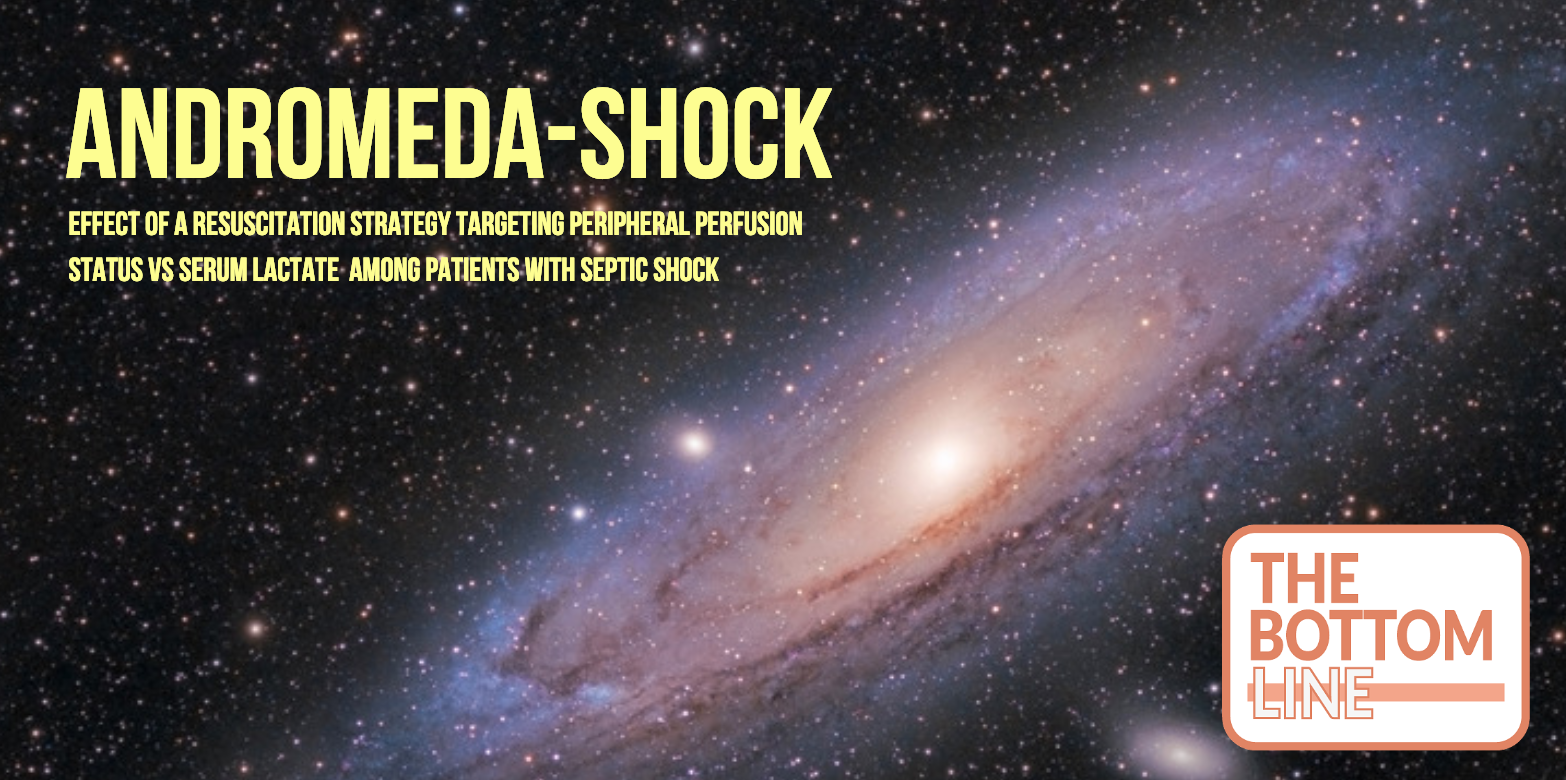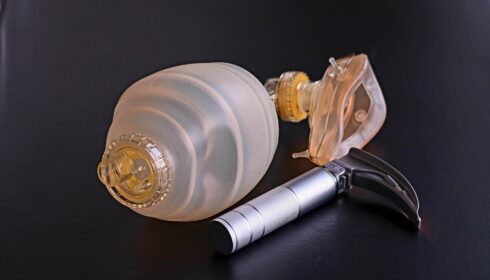ANDROMEDA-SHOCK

Effect of a Resuscitation Strategy Targeting Peripheral Perfusion Status vs Serum Lactate Levels on 28-Day Mortality Among Patients With Septic Shock
Hernandez. 2018. JAMA. 2019;321(7):654-664. doi:10.1001/jama.2019.0071
Clinical Question
- In adult patients with early septic shock, does peripheral perfusion-targeted resuscitation, compared to lactate level-targeted resuscitation, improve all cause mortality at 28 days?
Background
- The surviving sepsis campaign recommends targeting the normalization of lactate when resuscitating patients with septic shock. However problems exist with lactate as a target, including:
- Hyperlactatemia may be caused by factors other than tissue hypoperfusion (ie liver or kidney failure, metabolic changes or drugs)
- Lactate normalization may be delayed to after shock resolution
- Lactate measurements may not be universally available (ie in developing countries)
- Capillary refill time (CRT) is a marker of peripheral perfusion and sympathetic nervous system activation, and has been associated with organ failures and mortality. It may be an alternative target to lactate guided resuscitation, and has several potential advantages over lactate including:
- Rapidly responds to resuscitation
- Is easy to use
- Resource independent method of peripheral perfusion.
Design
- Multicenter, randomized controlled, superiority trial
- Random allocation, with central allocation concealment
- Randomization sequence by permutated blocks of 8, with 1:1 allocation via a computer program
- Clinicians non blinded
- Power calculation
- 420 patients were included to give a 90% power to detect an absolute risk reduction of of mortality from 45% to 30% (alpha 0.05) (Relative risk reduction of 33%)
- Primary outcome calculated using a cox proportional hazards after adjusting for 5 pre-specified covariates
- Intention to treat analysis
Setting
- 28 hospitals in 5 South and Central American countries (Argentina, Chile,
Colombia, Ecuador, Uruguay)
Population
- Inclusion:≥18 year old patients with early (<4hours) septic shock admitted to the ICU
- Septic shock was defined according to Sepsis-3 definition:
- Suspected or confirmed infection
- Lactate ≥2
- Vasopressors to maintain map ≥65 despite 20ml/kg over 60 minutes
- Septic shock was defined according to Sepsis-3 definition:
- Exclusion: Bleeding, severe ARDS, and dialysis patients, and those with a do not resuscitate status
- Study flow
- 1327 were assessed for eligibility
- 903 excluded (286 as ≥4 hours, 208 anticipated surgery or dialysis, 108 do not resuscitate, and 55 eligible but excluded due to logical reasons)
- 424 randomized (212 CRT target and 212 lactate target)
- 1327 were assessed for eligibility
- Baseline characteristics were similar between groups
- Mean age 63 years, APACHE score 22, mean SOFA score 9.65.
- Emergency department source of admission in 71%
- Intraabdominal most common source of infection (35%), followed by pneumonia (30%), and UTI (20%)
Intervention: peripheral perfusion-targeted resuscitation
- Capillary refill time was was measured every 30 mins, and then hourly after normalization for 8 hours
- CRT was measured by applying a glass microscope slide to the right index finger (at the distal phalanx) until the finger was blank then maintained for 10 seconds
- The time to return to normal skin colour was measured using a chronometer
- Abnormal CRT was defined as >3 seconds
- The goal of resuscitation was to normalise CRT <3 seconds
Control: lactate level-targeted resuscitation
- Lactate was measured every 2 hours for 8 hours
- The goal of resuscitation was to normalize or decrease lactate levels by 20% every 2 hours
Management common to both groups
- Patients who did not meet the above goals (CRT <3 seconds or lactate fall < 20% every 2 hours) were then managed with the following protocol over the 8 hour period of the study
- Step 1 – Fluid responsiveness
- Patients were first assessed for fluid responsiveness (most commonly Pulse Pressure Variation or change in Velocity Time Integral post passive leg raising)
- 500mls crystalloid bolus was given every 30 mins until goal was achieved, and then stopped if no longer responsive
- Step 2 – Vasopressor test
- Chronic hypertensive patients had a vasopressor test (Target MAP increased to 80-85)
- If CRT or lactate normalized, MAP was left at 80-85. If no change, then MAP was reduced back to target 65
- Step 3 – Inodilator test
- If patients still hadn’t met the target, then a inodilator test was done, where dobutamine or milrinone were introduced
- All other aspects were according to surviving sepsis guidelines
Outcomes
- Primary outcome:
- Day 28 mortality higher in the lactate group:
- 92 (43.4%) in the lactate group and 74 patients (34.9%) in the peripheral perfusion group
- hazard ratio, 0.75 [95% CI, 0.55 to 1.02]; P= .06; risk difference, −8.5% [95% CI, −18.2% to 1.2%
- Day 28 mortality higher in the lactate group:
- Impact of the protocol
- Compared to the lactate group, the CRT group had:
- 408 mls less fluid in first 8 hours
- less adrenalin use (9.9% vs 16.5% P=0.01)
- lower lactate at 48 hours and 72 hours: −0.36 mmol/L [95% CI, −0.62 to −0.09] vs −0.34 mmol/L [95% CI, −0.57 to −0.10]
- lower CRT levels at 4, 8, 24 hours
- CVP and central venous saturations did not differ
- Compared to the lactate group, the CRT group had:
- Secondary outcomes:
- SOFA score: lower at first 72 hours in CRT group: −1.00 [95% CI, −1.97 to −0.02]; P= .045)
- No other significant differences between group in other secondary outcomes
- Mechanical ventilation free days at day 28
- RRT free days at day 28
- Vasopressor free days at day 28
- ICU length of stay
- hospital length of stay
- Predefined subgroup analysis
- Baseline SOFA score <10 was associated with 28-day mortality HR of 0.46 (95% CI, 0.27 to 0.78), whereas SOFA score of >10 was not significantly different
Authors’ Conclusions
- Among patients with septic shock, a resuscitation strategy targeting normalization of capillary refill time, compared with a strategy targeting serum lactate levels, did not reduce all cause 28-day mortality
Strengths
- Multinational, randomized controlled trial, with allocation concealment
- Registered with ClinicalTrials.gov and pre-published statistical plan
- Time from eligibility to randomisation of 1.4 hours suggesting an early intervention
- Rapid recruitment (1 year)
- CRT assessment was standardised (using a chronometer, staff training, auditing, and periodic reinforcement)
- Reflects contemporary practices (eg fluid responsiveness)
- Good adherence to the protocol, with no loss to follow-up
Weaknesses
- Underpowered to answer the study question
- The sample size was calculated based on an ARR of mortality of 15%, which is unrealistic for most resuscitation based sepsis studies
- Therefore although the study resulted in a 8.5% mortality difference, this did not meet the pre-specified significance level (P=0.06)
- Thus there was a high chance of a type II (false negative) error
- A formal bayesian analysis would potentially allow a more nuanced interpretation of the trial
- Non blinding of clinicians may have led to additional changes in management resulting in bias for the intervention
- CRT group also required additional staff education while the lactate group did not, again potentially favouring the CRT intervention
- While both arms had CRT assessments every 30 minutes, protocol adjustments were only made every 2 hours for the lactate group
- The reduced frequency of protocol adjustments may have biased the result against the lactate group
- Complex intervention, making the causal relationship of outcome difficult to explain
- The two arms of the study triggered a complex protocol, of which parts lack a strong evidence base, and which may have biased the results for or against improved outcomes
- Furthermore, parts of the protocol are advanced (fluid responsiveness, vasopressor and inodilator assessments) and may not be generalisable to other hospitals
- The combination of a lactate based strategy and CRT strategy was not tested
- Although the CRT technique was standardised, there has been relatively little literature on this technique, and no evaluation of the inter-rater variability was conducted in the trial
- Day 28 mortality as a primary outcome in sepsis trials has been shown to still be unstable, and most major trials now using day 90
The Bottom Line
- This study suggests the exclusive use of CRT is a possible alternative to lactate as a resuscitation target in sepsis, especially in resource poor settings where lactate measurement is not routinely available
- My practise is to use a combination of lactate clearance and capillary return, which this study did not address, and therefore it will not change my practice.
- Further adequately powered studies, with validation of the CRT technique in other settings and countries, will be needed to make CRT my exclusive target for sepsis resuscitation
External Links
- [article] Effect of a Resuscitation Strategy Targeting Peripheral Perfusion Status vs Serum Lactate Levels on 28-Day Mortality Among Patients With Septic Shock
The ANDROMEDA-SHOCK Randomized Clinical Trial - [further reading] How Best to Resuscitate Patients With Septic Shock? Editorial. Derek Angus
- [further reading] ANDROMEDA-SHOCK: Peripheral Perfusion vs Serum Lactate in Septic Shock. REBEL-EM
- [further reading] Lactate is Dead! Long Live Lactate?
- [further reading] EM Nerd-The Case of the Deceitful Lantern
- [podcast] EMCrit Podcast 241 – Sepsis Update 2019
Metadata
Summary author: Aidan Burrell
Summary date: 13/03/2019
Peer-review editor: Steve Mathieu




They were at the bedside at the same timing intervals in both groups, they just were not basing care on the CRT in the lactate group.
Thanks @emcrit for pointing this out. I have updated the post to reflect this.
Hi! Both groups were assesed every 30 min by meassuring the CRT; the difference is that in the lactate group they didnt use the CRT to guide the resuscitation but the lactate every 2 hours.
Great review as always!
Also thanks – post has now been updated.
Great review
Done a quick Bayesian analysis of the ANDROMEDA-SHOCK data. A few things to consider
1) The issue with a ‘lower number’ unblinded study is that the outcome effect size may be a poor estimation of the true effect size AND may also be biased (so estimating a true effect size that is itself wrong). Bayesian analysis (or application of stats methods to data post-hoc) does not overcome this.
2) Its always useful for the reader to have their own prior opinion before interpreting the posterior probabilities i.e. decide whether you are skeptical, enthusiastic etc etc and then decide both what HR cut-off you will find relevant (e.g. 0.9) and at what probability (e.g. 80%).
Unfortunately I can’t seem to post pictures, but using a skeptical prior (similar parameters to the EOLIA bayesian analysis), the probability of a HR < 0.9 is 62% (in this study), whilst using a very enthusiastic prior (based upon the study's statistical plan minimal clinically important difference of 15%) the probability of a HR < 0.9 is 95%.
Hope this helps
ps this has been done by others already and can be found out there in social media!
Thanks Thomas – a very helpful addition
can someone please show me the chronometer used to test capillary refill?